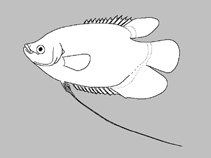Betta hipposideros Ng & Kottelat, 1994
Upload your photos and videos
Google imageNo image available for this species;
drawing shows typical species in Osphronemidae.
Google imageNo image available for this species;
drawing shows typical species in Osphronemidae.
Classification / Names ชื่อสามัญ | ชื่อพ้อง | Catalog of Fishes(สกุล, ชนิด) | ITIS | CoL | WoRMS | Cloffa
> Anabantiformes (Gouramies, snakeheads) > Osphronemidae (Gouramies) > Macropodusinae
Etymology: Betta: Malay/Javanese origin. Bleeker (1850, 1858) indicates Ikan Wadder Bettah as the local name of Betta trifasciata Bleeker, 1849 (now Betta picta, Valenciennes, 1846) in the Ambarawa Javanese dialect. Ikan Wader is a common Javanese name for smaller freshwater fishes, especially cyprinids (already used in Old Javanese). See Blust, R. & Trussel, S. Austronesian Comparative Dictionary. Web Edition (https://www.trussel2.com/acd/).
More on authors: Ng & Kottelat.
Etymology: Betta: Malay/Javanese origin. Bleeker (1850, 1858) indicates Ikan Wadder Bettah as the local name of Betta trifasciata Bleeker, 1849 (now Betta picta, Valenciennes, 1846) in the Ambarawa Javanese dialect. Ikan Wader is a common Javanese name for smaller freshwater fishes, especially cyprinids (already used in Old Javanese). See Blust, R. & Trussel, S. Austronesian Comparative Dictionary. Web Edition (https://www.trussel2.com/acd/).
More on authors: Ng & Kottelat.
Environment: milieu / climate zone / depth range / distribution range นิเวศวิทยา
; น้ำจืด กลุ่มสัตว์หน้าดิน,กลุ่มสัตว์พื้นท้องน้ำ. Tropical
การแพร่กระจาย ประเทศต่างๆ | พื้นที่จำแนกตาม FAO | ระบบนิเวศหลายระบบ | การปรากฏขึ้น,การเกิดขึ้น,พบ | Point map | การแนะนำ | Faunafri
Asia: known from Selangor and Perak in Malaysia. Its range extends to Riau Archipelago, Indonesia (Ref. 56386).
ขนาด / น้ำหนัก / Age
Short description เครื่องมือที่ใช้ในการแยกชนิดสัตว์,สิ่งมีชีวิตออกจากกัน | สัณฐานวิทยา | ความยาวต่างๆ
เงี่ยงครีบหลัง (รวม) : 1; ก้านครีบอ่อนที่หาง (รวม) : 8; เงี่ยงครีบก้น: 2; ก้านครีบอ่อนที่ก้น: 28. Differs from Betta chloropharynx in the following characters: horseshoe-shaped black throat mark (vs. µ-shaped black throat mark); presence of both dorsal and caudal transverse bars (vs. absence); more subdorsal scales (mode 6 1/2 vs. 5-6). It is distinguished from Betta renata in the following characters: horseshoe-shaped black throat mark (vs. kidney-shaped); non-spotted opercle (vs. spotted opercle); opercle with yellow or brown lower margin (vs. black margin); fewer postdorsal scales (mode 12 vs. 9 1/2); more anal fin rays (mode 30 vs. 29); more lateral scales (mode 32 vs. 31). Can be differentiated from Betta spilotogena in the following characters: horseshoe-shaped black throat mark ((vs. black median spot); non-spotted opercle (vs. spotted opercle); opercle with yellow or brown lower margin (vs. back margin); presence of both dorsal and caudal transverse bars (vs. absence); and more subdorsal scales (mode 6 1/2 vs. 5 1/2) (Ref. 56386).
Facultative air-breathing (Ref. 126274); Occurs in backwater peat swamps with substrate usually peat and leaf litter. Large fish are found in the flowing sections of the blackwater streams and smaller ones appear to prefer pools and slower flowing waters.
Life cycle and mating behavior วัยเจริญพันธุ์ | การสืบพันธุ์ | การวางไข่ | เซลสืบพันธ์ของเพศเมีย(ไข่) | ความดกของไข่ | ตัวอ่อน
Main reference
Upload your references | อ้างอิง | ผู้ประสานงาน | ผู้ร่วมมือ
Ng, P.K.L. and M. Kottelat, 1994. Revision of the Betta waseri species group (Teleostei: Belontiidae). Raffles Bull. Zool. 42(3):593-611. (Ref. 13093)
IUCN Red List Status (Ref. 130435: Version 2024-2)
Endangered (EN) (B1ab(iii)); Date assessed: 05 January 2019
CITES
Not Evaluated
Threat to humans
Harmless
Human uses
FAO - Publication: search | FishSource |
ข้อมูลเพิ่มเติม
Trophic ecology
รายการอาหาร
องค์ประอบของอาหาร
การบริโภคอาหาร
Food rations
ผู้ล่า
รายการอาหาร
องค์ประอบของอาหาร
การบริโภคอาหาร
Food rations
ผู้ล่า
Ecology
นิเวศวิทยา
นิเวศวิทยา
Population dynamics
Growth parameters
Max. ages / sizes
Length-weight rel.
Length-length rel.
Length-frequencies
Mass conversion
การทดแทนที่
อุดมสมบรูณ์
Growth parameters
Max. ages / sizes
Length-weight rel.
Length-length rel.
Length-frequencies
Mass conversion
การทดแทนที่
อุดมสมบรูณ์
Life cycle
การสืบพันธุ์
วัยเจริญพันธุ์
Maturity/Gills rel.
ความดกของไข่
การวางไข่
Spawning aggregations
เซลสืบพันธ์ของเพศเมีย(ไข่)
Egg development
ตัวอ่อน
พลวัตของสัตว์น้ำวัยอ่อน
การสืบพันธุ์
วัยเจริญพันธุ์
Maturity/Gills rel.
ความดกของไข่
การวางไข่
Spawning aggregations
เซลสืบพันธ์ของเพศเมีย(ไข่)
Egg development
ตัวอ่อน
พลวัตของสัตว์น้ำวัยอ่อน
Distribution
ประเทศต่างๆ
พื้นที่จำแนกตาม FAO
ระบบนิเวศหลายระบบ
การปรากฏขึ้น,การเกิดขึ้น,พบ
การแนะนำ
BRUVS - Videos
ประเทศต่างๆ
พื้นที่จำแนกตาม FAO
ระบบนิเวศหลายระบบ
การปรากฏขึ้น,การเกิดขึ้น,พบ
การแนะนำ
BRUVS - Videos
Anatomy
พื้นที่เหงือก
Brain
Otolith
พื้นที่เหงือก
Brain
Otolith
Physiology
Body composition
Nutrients
การใช้ออกซิเจน
รูปแบบการว่ายน้ำ
ระดับความเร็วในการว่ายน้ำ
Visual pigments
Fish sound
Diseases & Parasites
Toxicity (LC50s)
Body composition
Nutrients
การใช้ออกซิเจน
รูปแบบการว่ายน้ำ
ระดับความเร็วในการว่ายน้ำ
Visual pigments
Fish sound
Diseases & Parasites
Toxicity (LC50s)
Genetics
พันธุศาสตร์
Heterozygosity
อัตราพันธุกรรม
พันธุศาสตร์
Heterozygosity
อัตราพันธุกรรม
Human related
Aquaculture systems
ประวัติการเพาะเลี้ยงสัตว์น้ำ
สายพันธุ์
Ciguatera cases
Stamps, coins, misc.
Aquaculture systems
ประวัติการเพาะเลี้ยงสัตว์น้ำ
สายพันธุ์
Ciguatera cases
Stamps, coins, misc.
เครื่องมือ
E-book | คู่มือภาคสนาม | ผู้มีความชำนาญในเรื่องความถี่ของความยาว | เครื่องมือในการศึกษาชีวประวัติ | ตำแหน่งบนแผนที่ | Classification Tree
| Catch-MSY |
Special reports
Download XML
แหล่งที่มาจากอินเตอร์เน็ต
AFORO (otoliths) | Aquatic Commons | BHL | Cloffa | BOLDSystems | Websites from users | Check FishWatcher | CISTI | Catalog of Fishes: สกุล, ชนิด | DiscoverLife | ECOTOX | FAO - Publication: search | Faunafri | Fishipedia | Fishtrace | GenBank: genome, nucleotide | GloBI | Google Books | Google Scholar | Google | IGFA World Record | MitoFish | Otolith Atlas of Taiwan Fishes | PubMed | Reef Life Survey | Socotra Atlas | แผนภูมิชีวิตแบบต้นไม้ | Wikipedia: Go, ค้นหา | World Records Freshwater Fishing | Zoobank | บันทึกทางด้านสัตววิทยา
Estimates based on models
Phylogenetic diversity index (Ref. 82804): PD50 = 0.5000 [Uniqueness, from 0.5 = low to 2.0 = high].
Bayesian length-weight: a=0.01000 (0.00377 - 0.02651), b=2.97 (2.74 - 3.20), in cm total length, based on LWR estimates for this (Sub)family-body shape (Ref. 93245).
ระดับชั้นอาหาร (Ref. 69278): 3.3 ±0.4 se; based on size and trophs of closest relatives
ความสามารถในการกลับคืนสู่ปกติ (Ref. 120179): ความสูง, เวลาต่ำสุดที่จะทำให้ประชากรเพิ่มขึ้นเป็น 2 เท่าใช้เวลาน้อยกว่า 15 เดือน (Preliminary K or Fecundity.).
Fishing Vulnerability (Ref. 59153): Low vulnerability (10 of 100).




